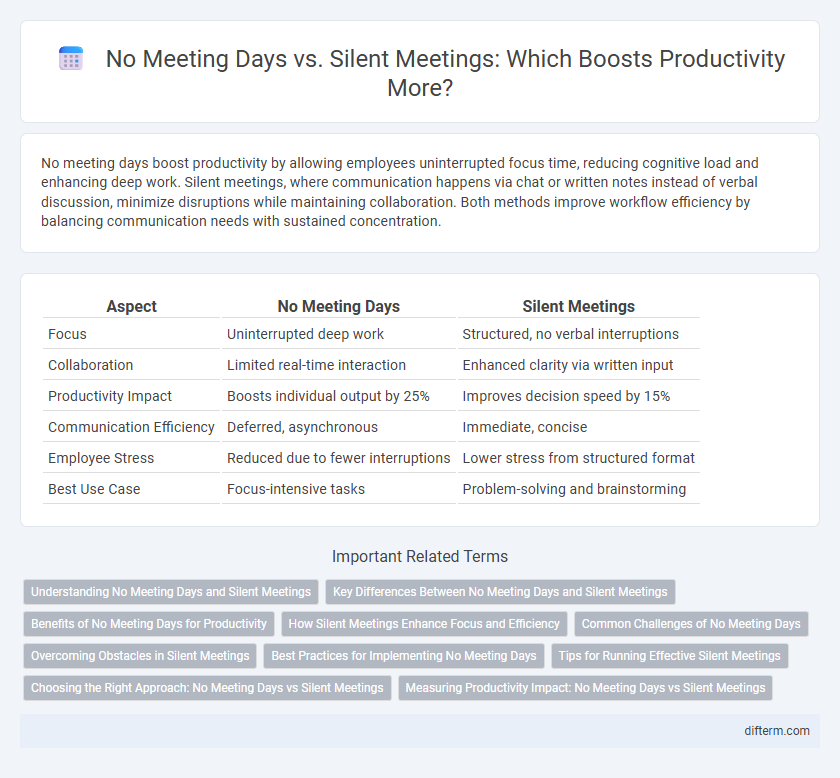No meeting days boost productivity by allowing employees uninterrupted focus time, reducing cognitive load and enhancing deep work. Silent meetings, where communication happens via chat or written notes instead of verbal discussion, minimize disruptions while maintaining collaboration. Both methods improve workflow efficiency by balancing communication needs with sustained concentration.
Table of Comparison
| Aspect | No Meeting Days | Silent Meetings |
|---|---|---|
| Focus | Uninterrupted deep work | Structured, no verbal interruptions |
| Collaboration | Limited real-time interaction | Enhanced clarity via written input |
| Productivity Impact | Boosts individual output by 25% | Improves decision speed by 15% |
| Communication Efficiency | Deferred, asynchronous | Immediate, concise |
| Employee Stress | Reduced due to fewer interruptions | Lower stress from structured format |
| Best Use Case | Focus-intensive tasks | Problem-solving and brainstorming |
Understanding No Meeting Days and Silent Meetings
No meeting days boost productivity by creating uninterrupted time blocks for deep work, reducing cognitive load and preventing meeting fatigue. Silent meetings, where participants communicate asynchronously via chat or collaborative documents, enable thoughtful responses and maintain focus without verbal interruptions. Organizations using no meeting days combined with silent meetings report higher employee engagement and improved task completion rates.
Key Differences Between No Meeting Days and Silent Meetings
No meeting days prioritize uninterrupted work by eliminating all scheduled conversations, boosting deep focus and overall productivity. Silent meetings allow participants to communicate asynchronously via chat or written formats, reducing verbal interruptions while maintaining collaborative input. The key difference lies in no meeting days blocking all live interactions, whereas silent meetings replace vocal discussion with quiet, text-based exchanges.
Benefits of No Meeting Days for Productivity
No meeting days significantly boost productivity by providing uninterrupted time for deep work, allowing employees to focus on complex tasks without constant distractions. These dedicated periods reduce cognitive switching costs associated with frequent meetings and foster heightened concentration and creativity. Organizations that implement no meeting days often report improved task completion rates and enhanced overall workflow efficiency.
How Silent Meetings Enhance Focus and Efficiency
Silent meetings enhance focus and efficiency by minimizing verbal interruptions, allowing participants to process information at their own pace. This method reduces cognitive load and prevents multitasking, leading to higher-quality contributions and faster decision-making. Unlike no meeting days, silent meetings maintain structured collaboration while preserving uninterrupted work time.
Common Challenges of No Meeting Days
No meeting days often struggle with maintaining team communication and timely collaboration, leading to potential project delays and confusion. Silent meetings, while intended to enhance focus, can result in misunderstandings due to lack of verbal cues and immediate feedback. Both approaches challenge organizations to balance uninterrupted productivity with effective, clear communication workflows.
Overcoming Obstacles in Silent Meetings
No meeting days boost productivity by eliminating interruptions, allowing deep work without context switching. Silent meetings reduce verbal distractions but introduce challenges like limited real-time feedback and potential misunderstandings. Overcoming obstacles in silent meetings requires clear agendas, structured communication tools, and explicit guidelines to ensure aligned collaboration and effective decision-making.
Best Practices for Implementing No Meeting Days
Implementing no meeting days boosts productivity by allowing uninterrupted focus time, reducing cognitive switching costs commonly caused by frequent meetings. Best practices include setting clear guidelines for when no meeting days occur, encouraging asynchronous communication methods, and designating silent meetings that use chat or email to maintain collaboration without disrupting deep work. Consistent evaluation of team feedback and adjusting meeting cadences ensures the no meeting policy aligns with workflow demands and maximizes employee efficiency.
Tips for Running Effective Silent Meetings
No meeting days boost productivity by eliminating interruptions and allowing deep work, while silent meetings maintain focus by using chat or collaborative documents instead of verbal discussions. To run effective silent meetings, prepare a clear agenda shared in advance, encourage concise written input from participants, and set time limits to ensure efficient decision-making. Prioritizing transparency and timely follow-ups optimizes collaboration without sacrificing individual focus.
Choosing the Right Approach: No Meeting Days vs Silent Meetings
No meeting days significantly boost deep work by eliminating all interruptions, allowing employees to fully immerse themselves in complex tasks and project execution. Silent meetings maintain scheduled collaboration but minimize verbal distractions, using chat or written updates to keep the workflow focused while preserving team alignment. Selecting between these approaches depends on organizational culture and the need to balance uninterrupted focus with essential communication.
Measuring Productivity Impact: No Meeting Days vs Silent Meetings
No meeting days and silent meetings both aim to enhance productivity by reducing disruptions, but their impacts differ significantly. No meeting days provide uninterrupted work time, leading to increased deep focus and task completion rates, while silent meetings rely on asynchronous communication, minimizing verbal interruptions yet still requiring scheduled attention. Measuring productivity impact involves evaluating metrics such as time-on-task, cognitive load, and project throughput to determine which approach better supports sustained workflow and reduces context switching.
no meeting days vs silent meetings Infographic

 difterm.com
difterm.com